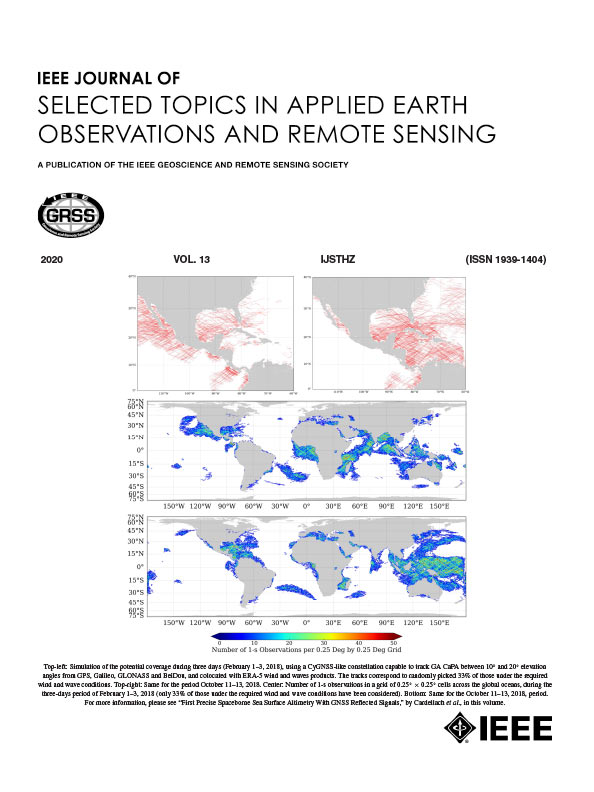基于机载合成孔径雷达的道路裂纹检测与方向估计
IF 5.3
2区 地球科学
Q1 ENGINEERING, ELECTRICAL & ELECTRONIC
IEEE Journal of Selected Topics in Applied Earth Observations and Remote Sensing
Pub Date : 2025-09-22
DOI:10.1109/JSTARS.2025.3613166
引用次数: 0
摘要
路面上的裂缝是一个重大的安全隐患,可能会发展成更大的坑洞,对车辆和乘客构成威胁。高分辨率机载SAR系统采集的合成孔径雷达(SAR)数据对路面变化非常敏感,可用于定期路况监测。本文提出了一种将自适应阈值算法与Radon变换相结合的道路裂缝检测方法,并对裂缝的严重程度和方向进行估计。在这种方法中,自适应阈值算法检测裂缝,而Radon变换使用来自sinogram最大Radon震级来定性量化裂缝的严重程度,并估计裂缝的方向为相对于真北的方位角。虽然该方法适用于各种机载SAR平台,但本研究以DLR F-SAR系统获取的空间分辨率为25 cm的x波段机载SAR数据为例进行了验证。检测到的裂缝和方向与谷歌地球图像进行了验证,显示与实际裂缝的位置和方向非常吻合。这项研究强调了机载SAR数据通过早期识别表面缺陷来支持预测性道路维护工作的潜力。本文章由计算机程序翻译,如有差异,请以英文原文为准。
Road Crack Detection and Orientation Estimation Using Airborne Synthetic Aperture Radar
Cracks on road surfaces are a significant safety hazard that can progress into larger potholes, posing risks to vehicles and passengers. Synthetic aperture radar (SAR) data acquired by high-resolution airborne SAR systems are sensitive to changes on the road surface and can be utilized for periodic road condition monitoring. This study proposes a novel method that combines an adaptive thresholding algorithm with the Radon transform for detecting road cracks and estimating both their severity and orientation. In this approach, the adaptive thresholding algorithm detects the cracks, while the Radon transform qualitatively quantifies their severity using the maximum Radon magnitude from the sinogram and estimates their orientation as bearing angles relative to true north. While the proposed method is applicable to various airborne SAR platforms, it is demonstrated in this study with X-band airborne SAR data acquired by DLR’s F-SAR system with a spatial resolution of 25 cm. The detected cracks and orientations were validated against Google Earth images, showing close agreement with the locations and orientations of the actual cracks. This research underscores the potential of airborne SAR data in supporting predictive road maintenance efforts through early identification of surface defects.
求助全文
通过发布文献求助,成功后即可免费获取论文全文。
去求助
来源期刊
CiteScore
9.30
自引率
10.90%
发文量
563
审稿时长
4.7 months
期刊介绍:
The IEEE Journal of Selected Topics in Applied Earth Observations and Remote Sensing addresses the growing field of applications in Earth observations and remote sensing, and also provides a venue for the rapidly expanding special issues that are being sponsored by the IEEE Geosciences and Remote Sensing Society. The journal draws upon the experience of the highly successful “IEEE Transactions on Geoscience and Remote Sensing” and provide a complementary medium for the wide range of topics in applied earth observations. The ‘Applications’ areas encompasses the societal benefit areas of the Global Earth Observations Systems of Systems (GEOSS) program. Through deliberations over two years, ministers from 50 countries agreed to identify nine areas where Earth observation could positively impact the quality of life and health of their respective countries. Some of these are areas not traditionally addressed in the IEEE context. These include biodiversity, health and climate. Yet it is the skill sets of IEEE members, in areas such as observations, communications, computers, signal processing, standards and ocean engineering, that form the technical underpinnings of GEOSS. Thus, the Journal attracts a broad range of interests that serves both present members in new ways and expands the IEEE visibility into new areas.

 求助内容:
求助内容: 应助结果提醒方式:
应助结果提醒方式:


